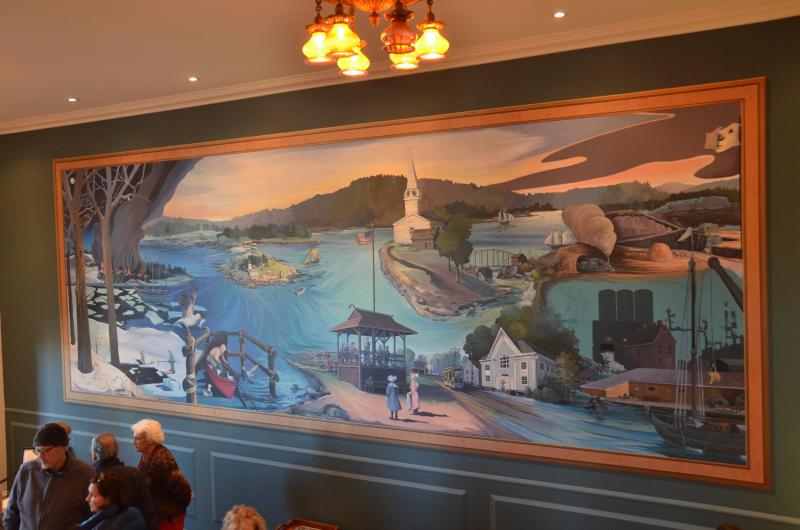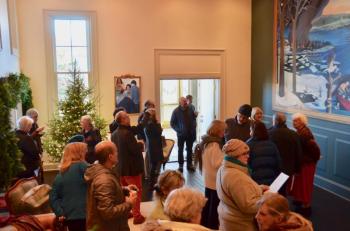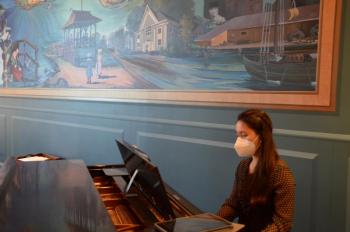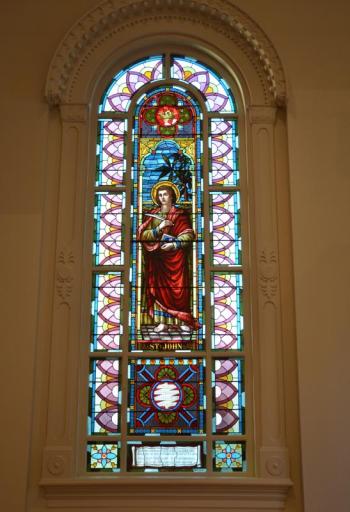ROCKPORT — More than a century of local history and culture are symbolized in a large new mural gracing almost the entire interior wall of an old church in Rockport Village. It is the culmination of a year’s worth of research and artistry, and at the heart of it is Rockport Harbor, considered by some to be amongst the most picturesque in the country. In 2008, Forbes magazine topped its list of prettiest American towns with Rockport.
But the landscape Rockport Harbor and Village have not always been so revered for its beauty.
There was a time when the economic center of Rockport — its harbor, especially where the Goose River empties into the ocean — was steeped in industrial enterprise, with a heavy cloak of smoke from smoldering lime kilns lingering overhead. The natural landscape was under assault by the demands of a quickly growing country that relied on Maine’s natural resources, and Rockport played an essential role in providing the mortar.
“We picked 1850 as our starting point,” said mural artist Peter Walls, describing those prolific years. “They called it purgatory here. Supposedly you couldn’t see the harbor.”
The century that followed was periodically energetic and vibrant, both economically and culturally. There was a flurry of construction in 1855 and again in the 1870s, buildings and old homes that now are included in the town’s Historic District, on the National Register of Historic Places Inventory, and listed on Page 9, 2004 Rockport Comprehensive Plan, Book II.
Walls, who lives in Stockton Springs and is known for his fine art and mural painting, has depicted that period with nine different visual stories and 30 images on a 31-foot-long by 16-foot-tall section of an interior wall in Pascal Hall, the former Third Baptist Church, built in 1854 on Pascal Avenue. With big, bold colors and smooth transitions, he artfully moves the eye from one significant development to another.
Walls spent the last year researching, with the help of Ken Gross, who directs the Camden Public Library’s History Center, and Penobscot Marine Museum photo archivist Kevin Johnson, that which he would ultimately represent visually in his mural.
The public was invited Dec. 10 to Pascal Hall to view the finished mural. The former church is now a privately-owned renovated community center/art gallery acquired by Linda and Griff Lesher, who also own Barnswallow Books on Russell Ave. in Rockport.
Linda Lesher holds high regard for older buildings in a community, and said she is simply a steward of them through these given years. In consultation with designer Leslie Curtis, who helped Lesher reappoint the hall after Lesher acquired it this year, she commissioned the work from Walls. Then Lesher stepped back to allow his creativity to bloom.
“Linda was great,” said Walls. “She would listen to ideas, and if I wanted to change, we could change.”
A steady stream of friends and art enthusiasts filtered through the room Dec. 10 to visually read the stories told in the mural. It is a quiet mural, with blues and browns and greens that tuck into the wall itself, al against a backdrop of carefully applied trompe-l'œil.
“Visitors have been sharing stories of their past experiences with the building with us – whether it was their long ago church or school; that they grew up as a neighbor or currently live here; and events they attended here over the years in its past iterations,” said Lesher. “People are connected to these old buildings.”
Walls explained that the mural incorporates nine different events.
“Not an easy task to execute, and there are illusions of perspective,” he said. “The idea is to be a work of art first and history would follow along with it.”
That history illustrates life in Rockport, when just down the street from the church lay docks and warehouses where shipbuilders built three- and four-masted schooners. Alongside were barrels of cargo, much of it limestone used for construction in the large cities along the Eastern Seaboard.
Further out in the harbor and Penobscot Bay, fishermen hauled in nets filled with herring and traps with lobsters. Over on Lily Pond, blocks of ice, a highly valued commodity, were hauled by teams of horses and stored in sawdust in waterfront warehouses before being shipped to the Caribbean.
A trolley line running from Thomaston to Camden was laid on Pascal Ave., in front of Pascal Hall, and wealthy rusticators from New York, Pennsylvania and Massachusetts would soon build large summer cottages along the harbor and Beauchamp Point. Some of them would go to to establish music schools that to this day attract well known concert musicians to play in the Midcoast opera houses.
Walls painted the mural with acrylic, using matte colors that cast no sheen. Weaving it altogether is the flow of water, blue water.
“There’s never a reflection of light,” he said, which helps to quiet the scene. “It’s soft. I think it fits the space rather than a big shiny work.”
He enjoyed this particular project, and explored his own sense of creativity.
“I’m not necessarily a figure painter,” he said. “I’m more of a nature-based painter, so having to do some figure work was fun and a challenge.”
To Lesher, the mural: “made us all think about where we have been. The harbor has gone through so many iterations. It’s really remarkable where we are today given the fact that there is layer upon layer of old communities, the industries that waxed and waned, and the wonderful cultural opportunities.”
She is looking forward to Pascal Hall’s new purpose, to expand, “upon our goal to create community in Rockport around books, art and culture through the programs we offer.”
Organizers at Pascal Hall will be considering gatherings where the mural would be open for public viewing about three times a year.






























